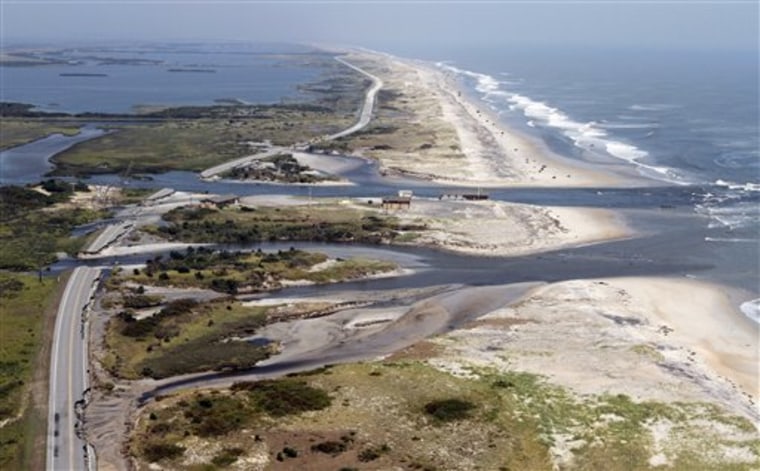There is probably no other road like it in America.
North Carolina Highway 12, a thin strip of asphalt on top of sand, bends into the Atlantic Ocean, connecting most of the Outer Banks with the mainland. It floods easily and washes away during hurricanes, leaving some to question whether it is worth pouring millions of dollars of repairs into such a vulnerable road. Some have suggested building a long bridge instead.
Irene took several big bites out of the highway, including one chunk that was nearly 160-feet long.
"It's a love-hate relationship, really," Kurt Kessler, who lives on Hatteras Island, said on a Facebook chat because he didn't have either cell phone or landline service after Irene hit almost a week ago. "12 is our main artery and we want to protect it. But again, we hate that we rely so heavily on it. This is one of those times you hate the fragile nature of Highway 12, but what are you going to do, you know? It comes with the territory."
Without Highway 12, the only way to get to Hatteras and most of the other nearby barrier islands would be by boat. The island is still not open to tourists, though the governor has said transportation officials would come up with a short-term solution for access by next week. The 140 mile-long road winds its way past unspoiled seashore as well as through villages packed with surf shops and hotels, and the black-and-white striped Hatteras Lighthouse.
At some spots, it's so narrow it feels like you can drag one arm through the Atlantic Ocean and the other through the Pamlico Sound. Sand washes onto the road during tropical weather, and it can sometimes pile up several feet high, making it impassable.
Hurricane Irene carved out several breaches in all, including two gaps that are new free-flowing inlets more than 120 feet.
Would a bridge be better?
In 2003, Hurricane Isabel also cleared out a piece of the highway. Ferries had to make round trips to Hatteras Village up to eight times a day, bringing bottled water, food, heavy machinery and relief workers while hauling out garbage and debris. Once again, emergency ferries are shipping goods to the isolated islands.
About 55,000 people live in the Outer Banks, which stretches south from the Virginia state line to Ocracoke Island. The Outer Banks includes all of Dare County and many of the towns along the coast, including Kitty Hawk, Kill Devil Hills and Nags Head.
It's hard to say how many tourists visit each year. But in the summer, tourism officials say there are 250,000 visitors in any given week. Hatteras in particular is popular for its open spaces. There, people get up in arms when a garish beach supply store sets up shop and complain when people don't turn out the lights at night — it makes the stars tougher to see.
Danny Couch, a business owner in the Hatteras Island town of Buxton, said the state should spend whatever it takes to reopen the highway as soon as possible. Even though many areas will still be cleaning up during Labor Day weekend, the fall is also a big earner for property rentals and tourism, he said.
"I'm all for protecting the environment, but I have a payroll to meet," he said.
Because of the pristine land the road runs through, environmental groups support a 17-mile bridge that would bypass the Pea Island National Wildlife Refuge and many of the areas where the breaches occurred. It would cost an estimated $1 billion, though advocates say in the long run it would be less expensive than constantly repairing the road and smaller bridge.
The state transportation agency believes it's too late for a long bridge. Instead, they've decided to replace the short Bonner Bridge, which had a projected lifespan of 30 years when it was built in 1962, and continue to repair Highway 12 as needed.
Constant repairs
East Carolina University geology professor Stanley R. Riggs, one of the authors of a book on North Carolina's coastline, believes the state should put in a ferry system that would connect all of the state's coastal communities.
"Islands are built by storms, maintained by storms and need storms to help them deal with rising sea level," he said. "The way we are using those barrier islands will guarantee their collapse with time because we are not allowing any of the natural processes to take place."
Greer Beatty, spokeswoman for the transportation agency, said it would not provide an estimate until next week for how long it might take to reopen Highway 12 or what the repairs might cost. After Isabel in 2003, it took weeks to restore the road at a cost of roughly $5 million.
Jim Trogdon, the agency's chief operating officer who is leading efforts to rebuild Highway 12, said most residents want the short bridge because it "maintains the character of the Outer Banks that we have all known for decades, and the locals support it, which is very important since NCDOT ultimately depends on the locals to define which transportation options they would like to see in their communities."
Gov. Beverly Perdue agreed.
"There are going to be those around the country saying 'why are you investing in that road again?' Until we can find a better way to move people on and off there, they're North Carolina citizens. They pay their taxes, and they've got to have a highway or road or bridge to travel on the same as the rest of us," she said.
Michael Biesecker in Raleigh and Mitch Weiss in Charlotte contributed to this report.
